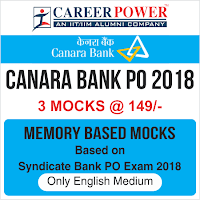Numerical Ability Section has given heebie-jeebies to the aspirants when they appear for a banking examination. As the level of every other section is only getting complex and convoluted, there is no doubt that this section, too, makes your blood run cold. The questions asked in this section are calculative and very time-consuming. But once dealt with proper strategy, speed and accuracy, this section can get you the maximum marks in the examination. Following is the
Numerical Ability quiz to help you practice with the best of latest pattern questions.
Q1. Veena obtained Rs. 8376 as simple interest on a certain amount 8% per annum after 6 yr. What is the amount invested by Veena?
(a) Rs. 17180
(b) Rs. 18110
(c) Rs. 16660
(d) Rs. 17450
(e) Rs. 17250
Q2. Two numbers are such that the sum of twice the first number and thrice the second number is 36and the sum of thrice the first number and twice the second number is 39. Which is the smaller number?
(a) 9
(b) 5
(c) 7
(d) 3
(e) 6
Q3. The difference between the present ages of Arun and Deepak is 14 yr. Seven years ago, the ratio of their ages was 5 : 7 respectively. What is Deepak’s present age?
(a) 56 yr
(b) 42 yr
(c) 63 yr
(d) 35 yr
(e) 45 yr
Q4. a, b, c, d and e are 5 consecutive even numbers. If the sum of ‘a’ and ‘d’ is 162, then what is the sum of all the numbers?
(a) 400
(b) 380
(c) 420
(d) 410
(e) 408
Q5. A cylinder, a hemisphere and a cone stand on the same base and have the same height . the ratio of the area of their curved surface is

Q6. The ages of Ranjana and Rakhi are in the ratio of 15 : 17 respectively. After 6 yr the ratio of their ages will be 9 : 10. What will be the age of Ranjana after 6 yr?
(a) 40 yr
(b) 30 yr
(c) 34 yr
(d) 36 yr
(e) 38 yr
Q7. The simple interest accrued on an amount of Rs. 17000 at the end of four years is Rs. 6800. What would be the compound interest accrued on the same amount at the same rate in the same period?
(a) Rs. 7889.7
(b) Rs. 8324
(c) Rs. 6990.5
(d) Rs. 7789.7
(e) None of these
Q8 In a class of 80 students and 5 teachers, each student got sweets that are 15% of the total number of students and each teacher got sweets that are 25% of the total number of students. How many sweets were there?
(a) 1030
(b) 1040
(c) 1050
(d) 1060
(e) 1080
Q9. Bhawna decided to donate 12% of her salary to an Orphanage. On the day of donation she changed her mind and donated Rs. 2400 which was 125% of what she had decided earlier. How much is Bhawna’s salary?
(a) Rs. 14750
(b) Rs. 16000.
(c) Rs. 18500
(d) Rs. 18000
(e) Rs. 19500
Q10. Gaurav spent Rs. 38460 on the renovation of his home. Rs. 24468 on buying home theater and the remaining 28% of the total amount he had as cash with him. What was the total amount?
(a) Rs. 92600
(b) Rs. 76500
(c) Rs. 87400
(d) Rs. 88400
(e) None of these
Directions (11-15): Study the following table carefully and answer the following questions
Given below is the table which shows the total number of voters in 5 villages, percentage of voters who voted and number of females, who have not voted.

Q11. What is the ratio of men who do not vote from village B and C together to the men who do not vote from village A and D together.
(a) 59 : 155
(b) 61 : 63
(c) 95 : 119
(d) 47 : 63
(e) 21 : 43
Q12. What is the difference between average of female who do not vote from village A, B and C together to the average of male who do not vote from village A, D and E together.
(a) 40
(b) 45
(c) 50
(d) 30
(e)55
Q13. Total females from all the villages together who do not vote is what percent of total voters from village C and D together.
(a) 15%
(b) 12%
(c) 10%
(d) 18%
(e) 20%
Q14. If voters from village A increases by 20% and females who do not vote increases by (100/3)% then men who do not vote increases or decrease by what percent consider % of voters who vote remain same. (approximately)
(a) 10%
(b) 18%
(c) 17%
(d) 13%
(e) 15%
Q15. Men who do not vote out of total voters is maximum for which village
(a) A
(b) B
(c) C
(d) D
(e) E





 Quantitative Aptitude Quiz For IDBI AM/E...
Quantitative Aptitude Quiz For IDBI AM/E...
 Quantitative Aptitude Quiz For IBPS RRB ...
Quantitative Aptitude Quiz For IBPS RRB ...





